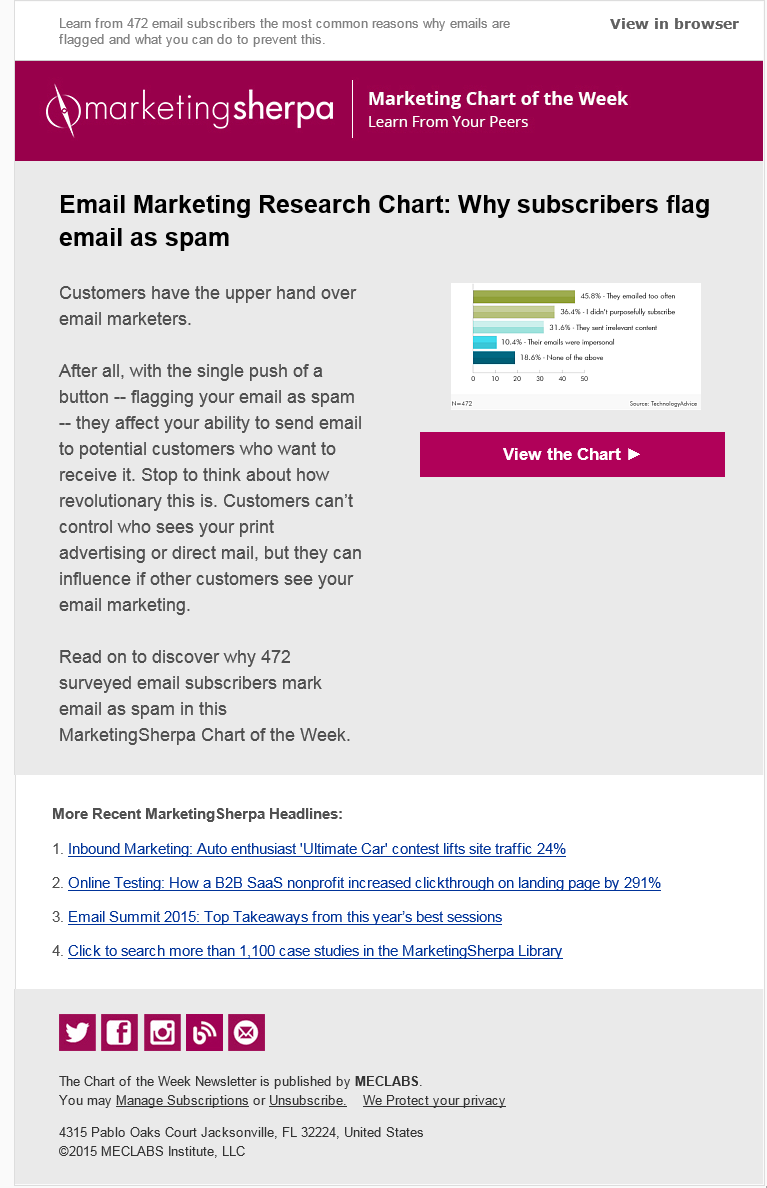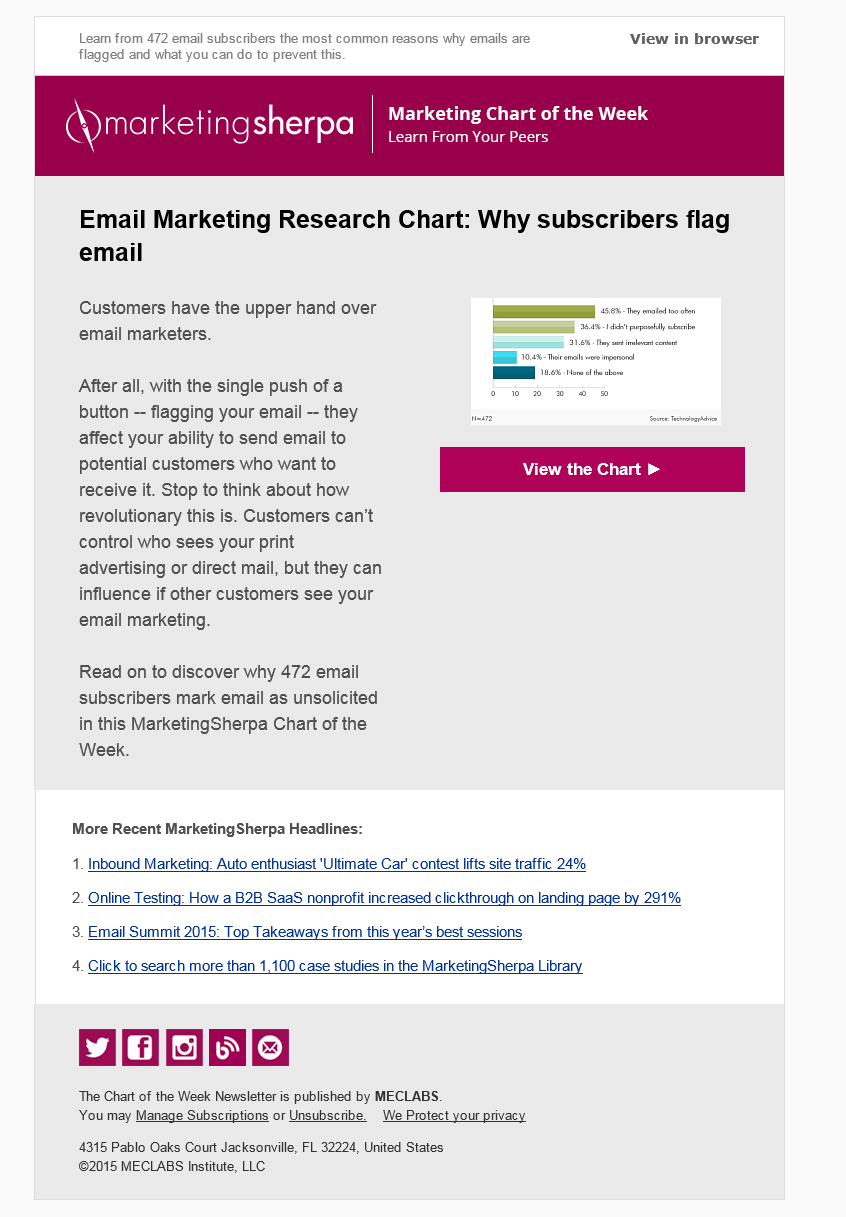OK, I’ll admit it. The headline to this blog post is absolute clickbait. I would never suggest any marketer send spam.
But, perhaps you should send “spam.” And “free.” And use other email spam trigger words in your email marketing.
Writing email with one hand tied behind our backs
Deliverability is a huge concern for email marketers. After all, if our emails never get into customers’ inboxes, they won’t be very effective.
One of the ways for our messages to avoid being labeled as junk email is to avoid specific words used by outright spammers.
But as a writer, avoiding these words can be difficult. After all, spammers use them because they are often the clearest, and sometimes most evocative ways, to communicate with potential customers. If we avoided all of these words in our email sends, we would seriously hamstring copywriters’ efforts to communicate with customers.
And then there’s the fact that the list of possible spam trigger words isn’t short. The list I linked to above included 393 words and phrases. This includes some pretty basic words such as “phone” and “now.”
Do spam trigger words really matter?
If you follow the latest research and top thinking on deliverability, these words don’t really matter. At least, not a whole lot (more on this topic at the end of this blog post).
Yet …
I’m pretty sure that if I step on a crack, I won’t break my mother’s back, but I’m still careful where I walk on the sidewalk. And how many elevators have you been in that don’t recognize having a 13th floor?
We logically don’t believe urban legends and superstitions, yet when blatantly confronted by them, something in our brain holds us back.
This was the position I found myself in when writing the MarketingSherpa Chart of the Week newsletter that featured this article — “Email Marketing Research Chart: Why subscribers flag email as spam.”
After I sent the final copy to our copy editor, Kayla Cobb, I had doubts. Second thoughts. Superstitions. What if that word — “spam” — really did send all of our email to the junk folder? Only one way to solve this conundrum: To the split test!
Control — More spam than a Hawaiian pizza
Subject Line: [Sherpa Chart] Why email is flagged as spam
Treatment — A vegetarian pizza
Subject Line: [Sherpa Chart] Why email is flagged
Results
As you can see, the open rates were not very different. In fact, there was not a significant difference at a 95% Level of Confidence — which is fine.
In this case, we weren’t necessarily testing for a lift. We were testing to avoid a loss. So, if these two treatments aren’t significantly different, we could go with the one we prefer (using the clearest word — “spam”).
Using that word did make a significant difference (at a 95% Level of Confidence) to the unique clickthrough rate. And it’s pretty obvious why …
Clarity trumps the spam filter
I’m sure you’ve heard the well-known maxim of Flint McGlaughlin, Managing Director and CEO, MECLABS Institute — “Clarity trumps persuasion.”
Well, in this case, being clear was more important than worrying about the “magic spam words” urban legend.
When we used the word “spam” in the email, it had a significantly higher unique clickthrough rate. This makes sense. To not use the word “spam” in an email about “spam,” I had to get pretty vague.
I mean, look at the wording in the treatment — “why subscribers flag email,” “mark email as unsolicited.” If we have a chart with research about spam, we should simply use the word spam.
We could all take some email copywriting advice from Russian poet and novelist Boris Pasternak — “For a moment she rediscovered the purpose of her life. She was here on earth to grasp the meaning of its wild enchantment and to call each thing by its right name.” By its right name.
What does this mean for your email deliverability challenges?
Deliverability can be a controversial topic. Much like SEO, there are so many complex factors involved in deliverability. The correct path isn’t always clear, and rumors abound. In fact, I was speaking on a webinar about marketing automation the other day when an attendee thought that ISPs automatically block email from automation platforms.
I’m not trying to give you a new hard-and-fast deliverability rule with this blog post. My main point is this: Challenge the urban legends. Test what works with your own lists.
Also, gain a broader understanding of deliverability. It’s not as simple as avoiding a few magic words.
When I mentioned this test to Justine Jordan, Marketing Director, Litmus, and asked her to provide a few tips to the audience, she said:
The truth is that there are no magic words when it comes to deliverability. Believe it or not, there are companies that need to sell ‘enhancement drugs’ legitimately and via email! The key comes down to having a stellar sending infrastructure set up and a squeaky clean sending reputation.
With the infrastructure and reputation aspects in good shape, content becomes less important.
However, poor content can tip the scales, landing you in the spam folder. Is the content of your email appropriate for your audience? Is it referencing appropriate websites? Does your subject line marry up with your content, or are you baiting and switching your recipients?
The real ‘secret’ to making it to the inbox is to create content that encourages subscribers to engage and interact with your messages. As discussed at the Email Evolution Conference, email providers like Gmail and AOL are looking for positive engagement signals — such as opening, replying and moving messages to another folder — more than they are looking for (or not looking for) specific words in your messages.
You can follow Daniel Burstein, Director of Editorial Content, MarketingSherpa, @DanielBurstein.
You might also like
Email Marketing: Microsoft Store uses relevance to increase sends by 300% and email revenue by 600% [MarketingSherpa case study]
Deliverability Basics [via Orlando Kalossakas on Litmus]
9 Best Practices for Protecting Your Email Reputation [MarketingSherpa case study]
Content Marketing: 3 tips for producing engaging email content [MarketingSherpa wrap-up]
Email Deliverability: 8 tactics to help you overcome rising B2B challenges [MarketingSherpa how-to]
Email Spam: Why phishing emails (unfortunately) work … and what marketers can learn from them







Daniel, this is an excellent post. Its easy to say “don’t believe urban legends – test yourself”, but you substantiate with a very good example. If this doesn’t convince someone to do their own A/B tests, I don’t know what would.
We handcraft each every one of our outreach emails, and I’m usually a bit scared to use pixel based open tracking on outreach emails. Do you have any thoughts on how (discerning) people usually respond when they know their opens are being tracked?
Niraj,
Thanks for the kind words.
I don’t have any quantitative evidence to back it up, but my opinion is that most people don’t know or actively think about pixel-based open tracking. And of those who are aware of it, they understand why you’re doing and the value of data to marketers to improve the customer experience, and would be OK with it.
However, that’s just my guess. If you’re highly concerned, you might look into tracking by “read rate” instead, which isn’t dependent on image downloads and essentially tracks when your email gets marked as “read” in an email client.
That is a deeper technical question and my focus is more on the content side, but here is a high-level explanation of the functionality… http://www.quora.com/How-would-you-calculate-Read-Rate-not-open-for-an-Email-Campaign
And here is a case study where the company tracked read rate as a metric, for an example… http://www.marketingsherpa.com/article/case-study/the-kentucky-derby-newsletter-gains